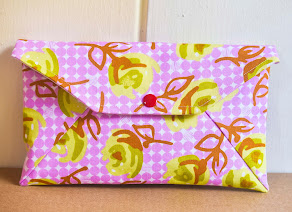Sick of drawstring bags, I thought about all the stuff I’m really scared of sewing. Like casing, gussets, bias binding, a straight line, evenly spaced buttonholes, zippers. Ah, zippers. I’m terrified of sewing zippers. The medical term is
zipperphobia. The one time I did a zipper, I hand sewed it. I’m adverse to any form of hand sewing unless it’s some embroidery my machine can’t handle. So how do I overcome
zipperphobia? I think the way to go is to sew a zippered pouch.
Zippered Pouch No. 1


I found a zipper tutorial at
http://www.twelve22.org/blog/2006/07/23/zipper_tutorial/. It looked really easy. (Easy always spells disaster for me)
I had some square fabric leftovers sewn in two rows and onto my old yellow bed sheet. I think I had seen this “pattern” in a bag making book at the National Library but I forgot the title of the book. The lining is my son’s old cot cover. You can’t see it but I have very thin batting in the bag for a quilted effect. The quilting bit was a bit unorganized. I just used a long ruler as a guide. Tip: The quilting lines need to be very precise otherwise the lines from the front and back piece won’t meet at the bottom seams. (Mine didn’t but it’s okay)
For the zipper bit, I managed to follow
Anna's twelve22 tutorial petty well until when I kinda mangled 2 good Organ needles. Tip: Always use manual control to ensure your needle does not touch the zipper foot before you proceed at lightning speed. Ah, why 2 needles? After mangling the first one, I replaced it and did exactly the same stupid thing as before. I forgot to ensure the needle does not hit the zipper foot. Where are my brains?
The bag turned out pretty well especially the zipper except I had to hand sew the end bits of the zipper together. I kinda feel I missed something in the tutorial to take care of the ugly end bits.
Zippered Pouch No. 2


Still sore from losing 2 good Organ needles, I googled some more and found a wristlet tutorial at
splityarn.
I like this tutorial a lot because the author talks to you like you really don’t know how to sew and that’s good because like I’ve discovered the hard way, I really don’t know how to sew.
I had this stem stitched embroidered strawberries on unbleached calico lying around and I thought it would go really well with my old gingham table cloth bits. You can’t see it but the whole bag is interfaced with fusible interfacing to achieve the crumpled vintage look. Okay, okay. It was all an accident. When I did the interfacing, the iron setting was way too hot and the fabric became all crumpled and I couldn’t get the bubbles out. But it looks good, doesn’t it? It’s all about the end result.
I followed the
splityarn tutorial every step of the way. I think I achieved a pretty good result. Best bit. No ugly end bits to take care of. Only thing is I regretted leaving too big a gap at the start of the zipper. Still I love the end result. I’m definitely using this wristlet. The gap isn’t that big, is it?
Zippered Pouch No. 3


I obsessed over the giant gap in zippered Pouch No. 2 and I felt I had to do another one. I made this one using the same method at
splityarn and this time I fixed the big gap.
I cut up my daughter’s old dress (the zipper didn’t work) and made a little pouch for her vanities. My girl thought I was fixing the zipper for her dress! The good news is she likes the pouch. The bad news is she’s still furious with me for cutting up her old dress.




















































